|
|
 |
Fiche d'espèce de Copépode |
|
|
Calanoida ( Ordre ) |
|
|
|
Diaptomoidea ( Superfamille ) |
|
|
|
Tortanidae ( Famille ) |
|
|
|
Tortanus ( Genre ) |
|
|
|
Tortanus ( Sous-Genre ) |
|
|
| |
Tortanus (Tortanus) forcipatus Giesbrecht, 1889 (F,M) | |
| | | | | | | Syn.: | Corynura forcipata Giesbrecht,1889; 1892 (p.525, 772, Descr.F, figs.F) | | | | Ref.: | | | Giesbrecht & Schmeil, 1898 (p.158, Rem. F); Sewell, 1914 a (p.249, Descr.M, fig.M); Früchtl, 1924 b (p.63); Steuer, 1926 a (p.60, figs.F,M, carte); Sewell, 1932 (p.399); Mori, 1937 (1964) (p.105, figs.F); Sewell, 1948 (p.324); Krishnaswamy, 1953 (p.140, figs.F); Chiba, 1956 (p.36, Rem.: p.43, figs. juv.F); Tanaka, 1965 (p.396, Rem.F); Chen & Zhang, 1965 (p.116, figs.F,M); Saraswathy, 1966 (1967) (p.85); Fazal-Ur- Rehman, 1973 a (p.113, figs.F,M); Goswami & Goswami, 1974 (p.109, fig. caryotypes); Kasahara, & al., 1974 (p.167, figs. egg, sea bottom; Marques, 1976 (p.999, figs.F); Hirota & Uno, 1977 (p.77, fig. egg, seasonal abundance); Goswami, 1977 a (p.154, figs.F, juv.); Ohtsuka, 1992 a (p.265); Chihara & Omori, 1997 (p.924, Pl.186: F,M); Al-Yamani & Prusova, 2003 (p.97, figs.F,M); Conway & al., 2003 (p.141, figs.F,M, Rem.); Mulyadi, 2004 (p.166, figs.F, Rem.); Phukham, 2008 (p.109, figs.F,M); Al-Yamani & al., 2011 (p.92, figs.F,M) |  issued from: Q.-c Chen & S.-z. Zhang in Studia Marina Sinica, 1965, 7. [Pl.52, 1-4]. Female (from E China Sea): 1, habitus (dorsal); 2, P5 (posterior). Male: 3, habitus (dorsal); 5, P5 (posterior).
|
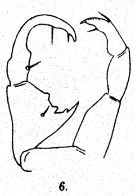 Issued from : R.B.S. Sewell in Spolia Zeylanica, 1914, 9. [Pl.XXI, Fig.6]. Male (from Gulf of Mannar): 9, P5. Nota: Proportional lengths of cephalothorax and abdomen 5:3. Proportional lengths of urosomites and furca as 14:15:12:9:13:70. Caudal rami symmetrical. Right A1 16-segmented (segments 1-5, 9-10, 19-21 and 22-25 fused), segments 17, 18 and 19-21 all armed with rows of needle-like teeth. Sewell points to the characteistics following: A1 17-segmented (segments 1-7, 9-10, 13-14 fused). P5 markedly asymmetrical.
|
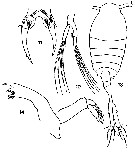 issued from : T. Mori in The pelagic Copepoda from the neighbouring waters of Japan, 1937 (2nd edit., 1964). [Pl.51, Figs.11-14]. Female: 11, P5; 12, A2; 13, habitus (dorsal); 14, Md.
|
 issued from : Fazal-Ur-Rehman in Crustaceana, 1973, 25 (2). [p.115, Figs.13-27]. Female (from off Karachi): 13, habitus (dorsal); 14, A1; 15, A2; 16-17, Md (mandibular blade); 18, Mx1; 19, Mx2; 20, Mxp; 21-24, P1 to P4; 25, P5; 26-27, Md (another specimen from Patany Bay, Siam). Nota: Caudal rami with distinct asymety, left ramus slightly narrower and smaller than the right. The specimens agree with the morphological characters described by Giesbrecht (1892), but differ in the following aspects. Denticles on the inner side of the left P5 are absent, as in Scott (1909) for a specimen collected by the Siboga Expedition; the marginal spines on the outer side of the right P5 are present in some cases, absent in others; specimens collected from Patany Bay, Siam, in 1909, revealed marked resemblances in the structure of P5, however, Md of the Siam's specimen differed in having 6 cutting teeth, as compared to 5 in the Karachi's specimen, which corresponds to the original figure and description by Giesbrecht (1892, Pl. 31, fig.5).
|
 issued from : Fazal-Ur-Rehman in Crustaceana, 1973, 25 (2). [p.114, Figs.1-12]. Male: 1, habitus (dorsal); 2, right A1; 3, A2; 4, Md (mandibular blade); 5, Mx1; 6, Mx2; 7, Mxp; 8-11, P1 to P4; 12, P5. Nota: A1 18-segmented, the right one being geniculated with the flexing located between the 14th and 15th segments; antennal segments between 13 and 15 finely serrated, the 8th and 11th segments carry small spines. 4th and 5th thoracic segments separated. Right P5 2-segmented, basal segment broad and triangular, it is provided with 2 finger-like projections set with nodulated protuberances (Pl. 1: top) and with a single seta; the terminal segment is strongly curved and arches over the first, carrying 4 small inner setae; the left P5 3-segmented, excluding the 1st (basal) segment; the proximal segment is the broadest but the two subsequent segments are smaller, each of these segments carries 1 seta on the outer margin; the terminal segment carries in addition 2 small spines (1 located terminally and 1 slightly posterior to it), 2 inner setae, and several distinct spinules near the tip arranged in 7 or 8 semicircular rows (Pl. 1: below)
|
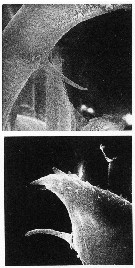 issued from : Fazal-Ur-Rehman in Crustaceana, 1973, 25 (2). [p.118, Pl.1]. SEM of P5: (top) right P5, showing the finger-like process bearing nodulated protuberances; (below) left P5, showing the arrangement of the spinules in distinct rows.
|
 Issued from : W. Giesbrecht in Systematik und Faunistik der Pelagischen Copepoden des Golfes von Neapel und der angrenzenden Meeres-Abschnitte. – Fauna Flora Golf. Neapel, 1892. Atlas von 54 Tafeln. [Taf.31, Figs.2, 3, 5, 7, 9]; As Corynura forcipata. Female: 2, A1 (ventral view); 3, Md (mandibular palp); 5, Md (biting edge of mandibular blade); 7, Mxp; 9, Mx1 (anterior view); 15, P5 (anterior view). Ps = left leg; Pd = right leg; B = basipod; Ri = endopod; Re = exopod; Li = inner lobe.
|
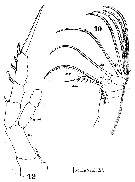 Issued from : W. Giesbrecht in Systematik und Faunistik der Pelagischen Copepoden des Golfes von Neapel und der angrenzenden Meeres-Abschnitte. – Fauna Flora Golf. Neapel, 1892. Atlas von 54 Tafeln. [Taf.31, Figs.410, 12; As Corynura forcipata. .Female: 10, Mxp1 (posterior view); 12, P2 (anterior view).
|
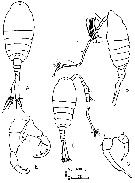 issued from : Y. Al-Yamani, V. Skryabin, A. Gubanova, S. khvorov & I. Prusova in Marine Zooplankton Practical Guide for the Northwestern Arabian Gulf, 2, 2011. [p.92, Fig.229]. Female (from Kuwait): A-B; habitus (dorsal and left lateral, respectively); C, P5. Male: D, habitus (dorsal); E, P5.
|
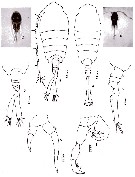 issued from : N. Phukham in Species diversity of calanoid copepods in Thai waters, Andaman Sea (Master of Science, Univ. Bangkok). 2008. [p.192, Fig.66]. Female (from W Malay Peninsula): a, habitus (dorsal); b-c, urosome (dorsal and lateral, respectively); d, P5. Male: e, habitus (dorsal); f, P5. Body length after the drawings: F = 1.307 mm; M = 1.387 mm.
|
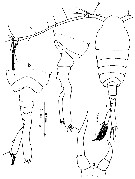 issued from : Mulyadi in Published by Res. Center Biol., Indonesia Inst. Sci. Bogor, 2004. [p.167, Fig.92]. Female (from Indonesian Seas): a, habitus (dorsal); b-c, last thoracic segments and urosome (dorsal and lateral, respectively); d, P5.
|
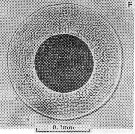 Issued from : R. Hirota & S. Uno in Bull. Plankton Soc. Japan, 1977, 24 (2). [p.80, Fig.3, F]. Pelagic eggs of Tortanus forcipatus from vicinity of Amakusa-Matsushima (western Kyushu, Japan).
| | | | | Ref. compl.: | | | C.B. Wilson, 1950 (p.345); Yamazi, 1958 (p.153, Rem.); Ganapati & Shanthakumari, 1962 (p.9, 16); Itoh, 1970 (tab.1); Kasahara & al., 1975 (p.25, eggs, cycles); Kasahara & al., 1975 (p.31, eggs in botton-sea muds); Patel, 1975 (p.660); Hanaoka, 1977 (p.267, 301, abundance); Kasahara & Uye, 1979 (p.63, resting eggs, hatching rates vs seasonal changes); Grice & Marcus, 1981 (p.125, Dormant eggs, Rem.: p.132); Sreekumaran Nair & al., 1981 (p.493), Chen Q., 1983 (p.133); Uye & al., 1984 (p.390, resting eggs-survival); Madhupratap & Haridas, 1986 (p.105, tab.1); Sarkar & al., 1986 (p.178); Dai & al., 1991 (tab.1); Yoo, 1991 (tab.1); Hwang & Choi, 1993 (tab.3); Uye & Kayano, 1994 (p.173, predatory feeding); Myung & al., 1994 (tab.1); Shih & Young, 1995 (p.74); Madhupratap & al., 1996 (p.77, table 2: resting eggs); Marcus, 1996 (p.144); Sharaf & Al-Ghais, 1997 (tab.1); Ramaiah & Nair, 1997 (tab.1); Achuthankutty & al., 1998 (p.1, Table 2); Hsieh & Chiu, 1998 (tab.2); Mauchline, 1998 (tab.8, 33, 35, 36, 40); El-Serehy, 1999 (p.172, Table 1, occurrence); Ueda & al., 2000 (tab.1); Dalal & Goswami, 2001 (p.22, fig.2); Rezai & al., 2004 (p.486, tab.2, 3, abundance); Chang & Fang, 2004 (p.456, tab.1); Wang & Zuo, 2004 (p.1, Table 2, dominance, origin); Kazmi, 2004 (p.229); Rezai & al., 2005 (p.157, Table 2, 5: spatial & temporal variations); Zuo & al., 2006 (p.163: tab.1); Dahms & al., 2006 (p.562, subitaneous & diapause eggsOhtsuka & al., 2008 (p.115, Table 5); Maiphae & Sa-ardrit, 2011 (p.641, Table 2, 3, Rem.); Chew & Chong, 2011 (p.127, Table 3, abundance vs location); Beltrao & al., 2011 (p.47, Table 1, density vs time); Dahms & al., 2006 (p.562, resting stages); Johan & al., 2012 (p.647, Table 1, fig.2, salinity range); Johan & al., 2012 (2013) (p.1, Table 1); Lee D.B. & al., 2012 (p.88, co-occurrence); Zhang H. & al., 2013 (p.57, Rem. p.58); Suzuki, K.W. & al., 2013 (p.15, Table 2, 3, 4, estuaries, annual occurrence); Seo & al., 2013 (p.448, Table 1, occurrence); Oh H-J. & al., 2013 (p.192, Table 1, occurrence); Ohtsuka & Nishida, 2017 (p.565, Table 22.1); | | | | NZ: | 4 | | |
|
Carte de distribution de Tortanus (Tortanus) forcipatus par zones géographiques
|
| | | | | | | | |  issued from : C.T. Achuthankutty, N. Ramaiah & G. Padmavati in Pelagic biogeography ICoPB II. Proc. 2nd Intern. Conf. Final report of SCOR/IOC working group 93, 9-14 July 1995. Workshop Report No. 142, Unesco, 1998. [p.8, Fig.6]. issued from : C.T. Achuthankutty, N. Ramaiah & G. Padmavati in Pelagic biogeography ICoPB II. Proc. 2nd Intern. Conf. Final report of SCOR/IOC working group 93, 9-14 July 1995. Workshop Report No. 142, Unesco, 1998. [p.8, Fig.6].
Salinity ranges for T. forcipatus in coastal and estuarine waters of Goa (India).
Shaded area indicates the range of higher abundance. |
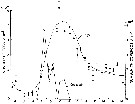 issued from : S. Kasahara, S. Uye & T. Onbé in Mar. Biol.,; 1975, 31. [p.26, Fig.4]. issued from : S. Kasahara, S. Uye & T. Onbé in Mar. Biol.,; 1975, 31. [p.26, Fig.4].
Seasonal cycles of abundance of Tortanus forcipatus populations and eggs in sea-bottom mud from Sensui-jima (Fukuyama, Japan).
Plankton collected in vertical hauls from 1.5 m above the bottom to the surface (copepods adults and late copepodids. Bottom sediment consisting of soft mud, collected by means of an Eckman-Birge grab-sampler. |
| | | | Loc: | | | Arabian Gulf, UAE coast, Indian, Madagascar, off Karachi (Manora Channel and Korangi), India (Saurashtra coast, W, Bombay, Goa, Lawson's Bay, Hooghly estuary), E India (coastal), Malaysia (Kurau River, Perai River estuary, off Penang Is.), W Malay Peninsula (Andaman Sea), Straits of Malacca, Sangga estuary (mid-estuary to offshore), G. of Thailand, Malaysia (Sarawak: Bintulu coast), Java (off Labuan, off Tegal, off Surabaya), Philippines, China Seas (Bohai Sea, Yellow Sea, East China Sea, South China Sea, Amoy, Xiamen Harbour, Jiaozhou Bay, Hong Kong), Taiwan (W, Kaohsiung Harbor), S & W Korea, Asan Bay, Geumo Is., Japan (Kyushu: Ariake Bay, Fukuyama Harbor, Seto Inland Sea, Tanabe Bay, Fukuyama, south estuaries: Chikugo, Midori & Kuma Rivers) | | | | N: | 89 | | | | Lg.: | | | (47) F: 1,35-1,25; (91) F: 2-1,2; (119) F: 1,09; (290) F: 1,25-1,35; M: 1-1,05; (333) F: 1,95; 1,92; (530) F: 1,1; (644) F: 1,27-1,25 M: 1,086-0,936; (645) F: 1,91-1,26; M: 1,079-1,006; (762) F: 1,35-1,09; M: 1,05-1; (937) F: 1,31-1,46; M: 1,09-1,17; (991) F: 1,25-1,91; M: 1,01-1,08; (1085) F: 1,1-1,6; M: 0,95-1,2; (1122) F: 1,25; {F: 1,09-2,00; M: 0,94-1,20} | | | | Rem.: | néritique.
Voir aussi les remarques en anglais | | | Dernière mise à jour : 07/06/2020 | |
|
|
 Toute utilisation de ce site pour une publication sera mentionnée avec la référence suivante : Toute utilisation de ce site pour une publication sera mentionnée avec la référence suivante :
Razouls C., Desreumaux N., Kouwenberg J. et de Bovée F., 2005-2024. - Biodiversité des Copépodes planctoniques marins (morphologie, répartition géographique et données biologiques). Sorbonne Université, CNRS. Disponible sur http://copepodes.obs-banyuls.fr [Accédé le 19 avril 2024] © copyright 2005-2024 Sorbonne Université, CNRS
|
|
 |
 |
















